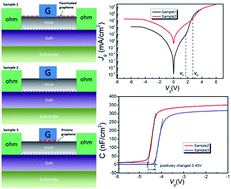Passivation effect of graphene on AlGaN/GaN Schottky diode
Abstract
Two dimensional graphene is a potential separation membrane and can improve interfacial conditions. In this paper, graphene was transferred to the surface of a AlGaN/GaN Schottky diode to investigate its influence on surface donor-like states (SDS) and Schottky barrier height. A fluorinated insulating monolayer of graphene transferred onto the AlGaN surface can suppress the surface leakage current by one order of magnitude at reverse and low forward bias. Meanwhile, a pristine monolayer of graphene under the gate metal can effectively reduce the gate current and shift the flat-band voltage positively by 0.45 V. Electrons from graphene can be trapped by SDS on the AlGaN surface and form a dipole layer. Some of the SDS become electrically neutral, and graphene as a separation membrane reduces SDS generated from AlGaN autoxidation. Therefore, two dimensional electronic gases (2DEG) can be depleted at higher gate bias, while the surface leakage path is cut off.


 Please wait while we load your content...
Please wait while we load your content...